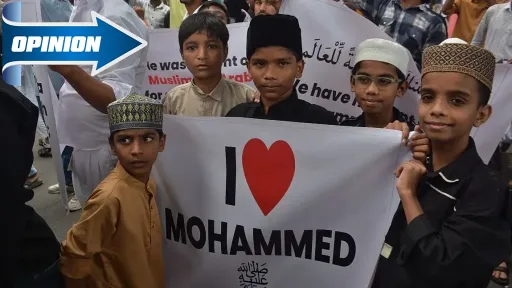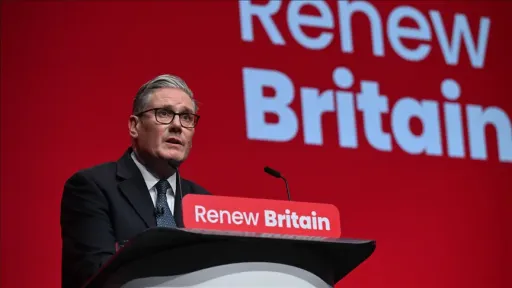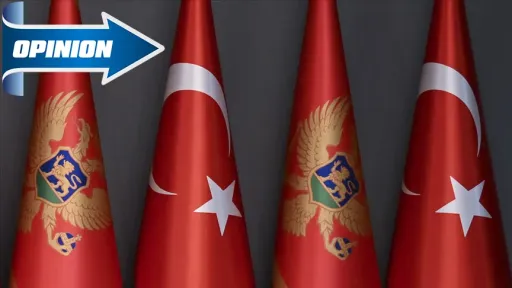Beyond Islamophobia: India cracks down on 'I Love Muhammad' posters

“Islamophobia” cannot describe the intensity currently being perpetrated against India’s largest minority, Muslims, today. It is a story that goes much further than that, since it is being openly said in India that “a nation without mosques or Muslims is needed.”
This is a wave of organized hatred, institutionalized prejudice and collective hostility that is difficult to capture in words. Perhaps “anti-Islam” is a more appropriate, but still inadequate, term. What is happening is not merely a clash of ideologies, but a full-blown story of identity degradation and the denigration of faith, which is no longer possible to ignore.
Case-by-case anti-Islam
In Godhra city, Gujarat, a young Muslim man named Zakir Jhabha held a poster reading “I Love Muhammad” and shared it on social media. What followed was something he could never have imagined. Police arrested him for this act, treated him as a “criminal,” and subjected him to a brutal beating.
The incident sparked protests by local Muslim youth outside the police station, demanding accountability for the violence. In response, police accused the demonstrators of vandalism, carried out a baton assault, arrested 17 people, and filed cases against 88 others. Some protesters were even tied with ropes and paraded through the streets.
In Saharanpur, Uttar Pradesh, a Muslim youth stood outside the Jama Masjid after Friday prayers holding a poster that read “I Love Muhammad.” Police intervened, confiscated and tore the poster and later took him into custody. Similar incidents happened in Budaun, Muzaffarnagar, Davanagere and Kashipur as the police stated that these posters could create disturbances.
In Davanagere, so far, three First Information Reports (FIRs) have been filed against nearly 100 individuals in relation to the incident.
In Kashipur, Uttarakhand, police arrested eight people and detained 10 others. According to reports, nearly 500 individuals, including children as young as 10 to 12 years old, have had cases registered against them. Allegations have also emerged of mistreatment of minors in custody, with some children reportedly beaten and pressured into silence. Observers note that the events in Kashipur are not isolated but part of a broader pattern of discriminatory state action against Muslims in India.
How did it start?
The current wave of controversy traces back to Sept. 4, during Eid Milad-un-Nabi, in the Syed Nagar area of Kanpur, Uttar Pradesh. On that day, local Muslim youth put up a signboard reading “I Love Muhammad” in Zafarwali Street. Members of Hindutva groups opposed the display, reportedly raising anti-Muslim slogans and claiming the banner was an attempt to “start a new tradition” that they would not tolerate.
Despite these confrontations, police took no action against the groups involved. Instead, on Sept. 10, police registered an FIR naming 12 Muslims and listing 14-15 others as unidentified. Police stated that the FIR was not filed over the banner itself but because a tent had been set up outside a designated area. However, the FIR explicitly mentions that members of the Muslim community attempted to begin a new tradition by displaying the banner, which the opposing group objected to. The complaint was filed by police personnel deployed during the procession.
The phrase “I Love Muhammad,” a simple expression of devotion and faith, has since grown into a campaign across India. The first protests began in Kanpur, where Muslims demanded the withdrawal of the FIR, but the administration did not act. Soon after, people in other cities also displayed similar posters, as a peaceful show of dissent against the police action. Yet, instead of respecting this form of expression, authorities in several states have responded with arrests and violence. Statements from political leaders have also begun to surface, revealing openly anti-Islam attitudes.
Is loving Muhammad a crime?
Indian Muslims are questioning why expressing love through posters or banners reading “I Love Muhammad” has sparked so much hostility. Since when did expressing affection become a crime? How could it harm anyone? Displaying such a message is not against the Constitution of India, and declaring it a criminal act raises serious legal and civil concerns.
Tensions escalated on Sept. 26 after Friday prayers in Bareilly, Uttar Pradesh, when police intervened to stop a protest linked to the “I Love Muhammad” campaign, citing a lack of permission. Authorities closed access to Islamia Ground, where the Muslims planned to gather, and attempted to disperse the crowd. Reports indicate that this led to slogans being raised and, allegedly, stone-pelting. Police then carried out a baton charge, reportedly beating people as they fled, resulting in chaos and multiple injuries.
A total of 10 FIRs have been registered across different police stations in connection with the incident in the same city. So far, 82 people have been arrested, including two individuals who were wounded by gunfire in their legs during an encounter and subsequently detained. A prominent muslim figure, Maulana Tauqir Raza Khan, was the first to be arrested; according to reports, his family has also since become the target of enforcement actions. Media coverage indicates that bulldozers were used to demolish the homes of his relatives.
These figures are a sign of how a peaceful slogan, an expression of devotion and love, was transformed into state repression and public anxiety. What is surprising is that the head of the administration responsible for creating a favorable situation for the people, the Chief Minister of Uttar Pradesh, Yogi Adityanath, openly threatened Muslims, saying: “Remember! Whenever you dare to do so, you’ll get beaten just like you were beaten inside Bareilly...” Not stopping there, he added: “We will teach you such a lesson that even your future generations will not dare to riot...”
Broader political context
In many cities, streets regularly resonate with chants of "Glory to Lord Rama" during Hindu festivals, processions proceed without interference and political banners are displayed in every corner of the city. Yet, when Muslims peacefully express their feelings through banners, authorities respond swiftly with FIRs, arrests and charges. This double standard is no longer just a matter of the “rule of law,” but has become a symptom of deep-rooted anti-Muslim hostility. The silence, or at times, complicity, of state institutions suggests that these are not isolated incidents, but part of a clear message and systematic pattern of tacit approval of Hindutva groups.
The question is not why Muslims display banners, but whether freedom of religious expression is equally protected for all citizens in India. If the answer is yes, then why are Muslims being specifically targeted over a mere banner? This is not just about one poster; it raises fundamental questions about the Constitution and the equal right of all citizens to practice their faith freely.
by Afroz Alam Sahil-DailySabah
About the author: Award-winning journalist, author of seven books and a leading Right to Information Act (RTI) investigator in India.







